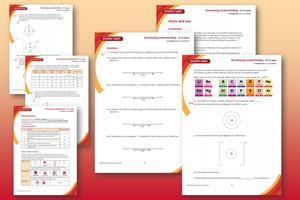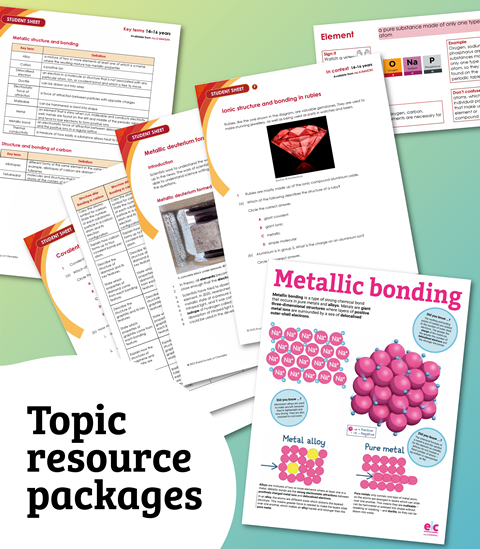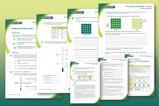Support your learners to develop mental models and deepen understanding of atoms and ions
-

Download this
A ramped worksheet to help learners develop their mental models of atoms and ions. With icons to indicate the conceptual level/s of each question.
View and download more Developing understanding worksheets
Learning objectives
- Complete number line diagrams to show why an atom has no overall charge or an ion has the given charge.
- Distinguish an atom from an ion when given numerical information about the number of protons and electrons.
- Draw electron configuration diagrams for atoms and ions.
- Describe how an atom becomes an ion.
- Identify an atom or ion from the number of protons and electrons.
This resource aims to develop learners’ understanding of atoms and ions. The questions encourage learners to compare the numbers of protons and electrons to calculate charge. As a result, learners should develop more secure mental models to support their thinking about this topic.
- When to use? Use after initial teaching or discussion of this topic to develop ideas further. You can also use as a revision activity.
- Group size? Suitable for independent work either in class or at home. Or use the questions for group or class discussions.
- How long? 15–30 mins
Johnstone’s triangle
Johnstone’s triangle is a model of the three different conceptual levels in chemistry: macroscopic, symbolic and sub-microscopic. You can use Johnstone’s triangle to build a secure understanding of chemical ideas for your learners.
Introduce learners to Johnstone’s triangle with our Atoms and ions Johnstone’s triangle worksheet which guides learners to think about copper atoms and copper ions at a macroscopic, sub-microscopic and symbolic level after observing a demonstration of metal displacement.
Further reading
Read more about how to use Johnstone’s triangle in your teaching with these articles:
- Develop deeper understanding with models
- Improve students’ understanding with Johnstone’s triangle
- Practical ideas for using Johnstone’s triangle
Norman Reid’s book The Johnstone Triangle: The Key to Understanding Chemistry provides a more in-depth overview, the first chapter is available to read online.
Johnstone’s triangle and this resource
The icons in the margin indicate which level of understanding each question is developing to help prompt learners in their thinking.
- Macroscopic: what we can see. Think about the properties that we can observe, measure and record.
- Sub-microscopic: smaller than we can see. Think about the particle or atomic level.
- Symbolic: representations. Think about how we represent chemical ideas including symbols and diagrams.
The levels are interrelated, for example, learners need visual representation of the sub-microscopic in order to develop mental models of the particle or atomic level. Our approach has been to apply icons to questions based on what the learners should be thinking about.
Questions may be marked with two or all three icons, indicating that learners will be thinking at more than one level. However, individual parts of the question may require learners to think about only one or two specific levels at a time.
Support
This worksheet is ramped so that the earlier questions are more accessible. The activity becomes more challenging in the later questions. You can give extra explanations for the more challenging questions. If completing as an in-class activity it is best to pause and check understanding at intervals, as often one question builds on the previous one.
It is useful for learners to observe macroscopic properties first-hand. You could circulate examples of substances in the classroom, run a class practical of a chemical reaction or show a teacher demonstration of properties.
Give learners physical models to use and manipulate, such as plasticine, or use the PhET Build an atom simulation.
Additional support may be needed for any learners still lacking in confidence in the required symbolic representation, for example by sharing and explaining a diagram or a simulation that can show movement of the particles.
Answers and guidance
There are six multi-part questions in the student worksheet. The first question supports learners to connect their understanding of positive and negative sub-atomic particles (sub-microscopic understanding) to mathematical understanding of adding positive and negative numbers using the visual aid of a number line. Question 2 develops learners confidence in determining the overall charge of a combination of protons and neutrons.
Questions 3, 4 and 5 develop learners’ understanding of how to represent the electronic structure of an atom and an ion (symbolic) using the atomic number from the periodic table (sub-microscopic understanding). The final question develops learners’ understanding of how to use a combination of information on the number of protons and an electron structure diagram (symbolic understanding) to identify an atom or ion (sub-microscopic understanding).
Downloads
Developing understanding of atoms and ions student sheet
Handout | PDF, Size 0.28 mbDeveloping understanding of atoms and ions teacher notes and answers
Handout | PDF, Size 0.29 mbDeveloping understanding of atoms and ions student sheet
Editable handout | Word, Size 0.57 mbDeveloping understanding of atoms and ions teacher notes and answers
Editable handout | Word, Size 0.58 mb


































No comments yet